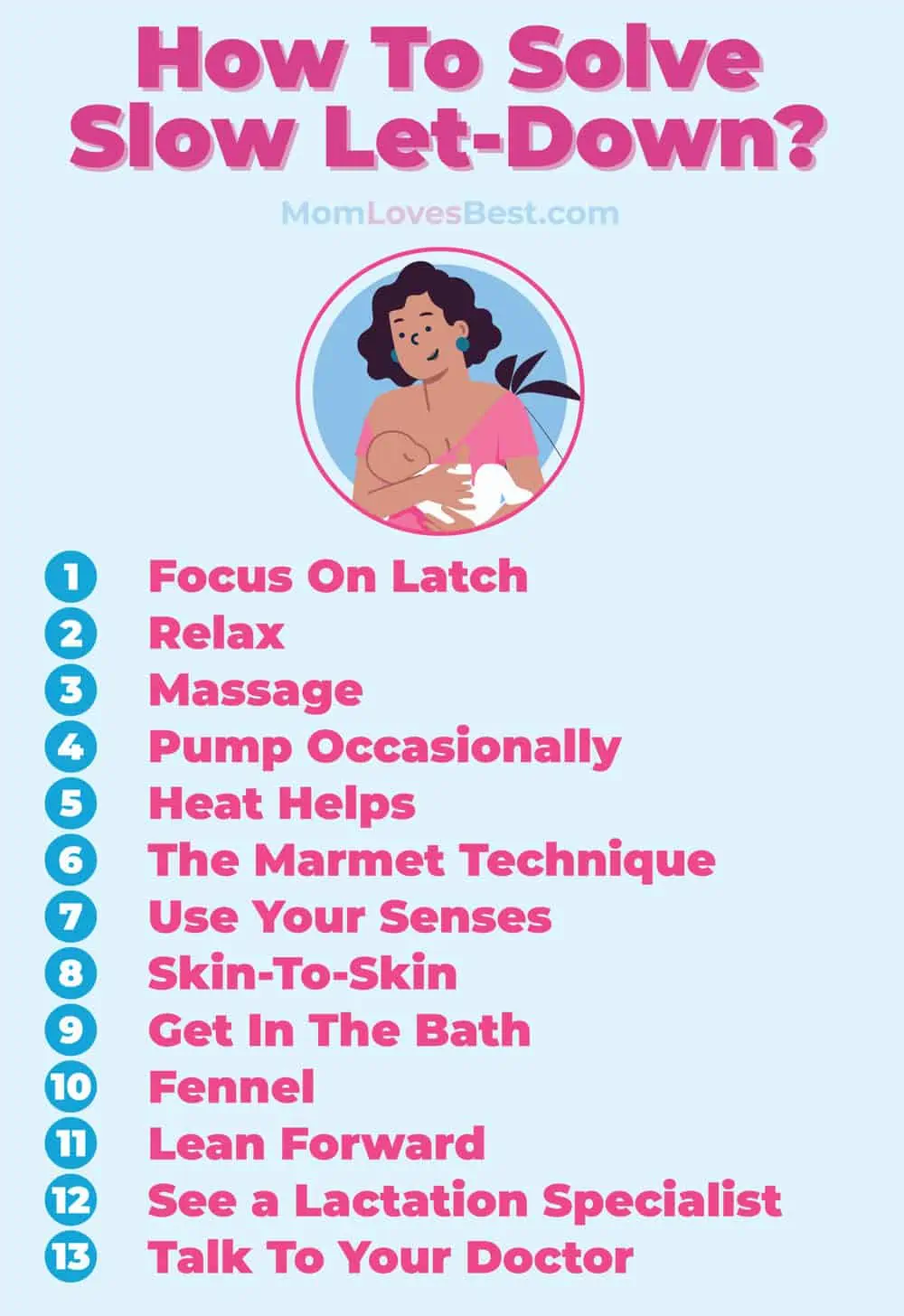You’re tired, your baby is hungry, and you are waiting for that familiar tingly sensation, but nothing is happening. It is incredibly frustrating when you don’t feel your milk let down, or when the flow seems too slow to satisfy your little one.
Take a deep breath. While it feels stressful in the moment, let-down issues are temporary and fixable. Most new moms bump into breastfeeding hurdles in those early days.
You can learn to spot the signs of a successful let-down and use simple tricks to get things flowing faster. Here is how to get your milk moving again.
Key Takeaways
- The mechanism: Let-down happens when hormones (prolactin and oxytocin) trigger your breast muscles to squeeze milk into the ducts.
- Common blockers: Stress, pain, cold temperatures, and caffeine can inhibit the oxytocin release needed for let-down.
- Quick fixes: warmth, gentle massage, skin-to-skin contact, and deep breathing often speed up the reflex.
- When to get help: If your baby creates fewer wet diapers or seems constantly unsatisfied, contact a lactation consultant immediately.
What Is Your Let-Down Reflex?
When your baby latches on, their sucking stimulates nerves that signal your brain to release two key hormones: prolactin and oxytocin (1). Prolactin tells your body to produce more milk, while oxytocin triggers the “let-down” reflex that pushes the milk out to your baby.
Many moms describe this as a tingling, pins-and-needles, or itchy feeling in the breast. Others feel a sudden warmth or pressure.
However, some women never feel a strong sensation, yet they breastfeed perfectly fine. As your body adjusts to the breastfeeding process, those intense physical feelings often fade.
If you don’t feel the “whoosh,” look for these signs instead:
- Rhythmic swallowing: Listen for a pattern of suck-swallow-breathe.
- Leaking: You might see milk dripping or spraying from the other breast.
- Baby’s body language: Your little one relaxes, and their hands open up.
What Causes a Slow Let-Down?
A slow let-down can turn nursing into a battle. Your baby might pull off, cry, bite, or get fussy because the milk is not coming fast enough. This creates a cycle of stress that only makes the problem worse.
Several factors can hit the brakes on your milk flow:
- Stress and anxiety: Worrying about milk supply is the number one mood killer for oxytocin.
- Physical discomfort: Sore or cracked nipples cause pain that inhibits flow.
- Cold temperatures: shivering makes your body tense up.
- Lifestyle factors: High caffeine intake, smoking, or alcohol consumption.
- Poor latch: If the baby isn’t stimulating the right nerves, the brain doesn’t get the signal.
- Previous surgeries: Nerve damage from breast surgery can interrupt the signaling pathway.
How Can I Solve Slow Let-Down?
If your flow is sluggish, do not panic. Panic releases adrenaline, which fights against oxytocin. Instead, try these proven methods to encourage your body to release the milk.
1. Fix the Latch
A shallow latch is not just painful; it fails to hit the nerve sensors required to start milk flow. Pain inhibits let-down.
Ensure your baby’s mouth is wide open like a yawn before they latch. Their lips should be flanged outward (like a fish), covering a good portion of the areola, not just the nipple.
2. Breathe and Relax
This sounds simple, but it is essential. Tension stops let-down. Before you nurse, drop your shoulders away from your ears. Take three deep belly breaths. Distract yourself by scrolling on your phone or humming a low tune to calm your nervous system.
3. Use Massage
Give your body a manual assist. Gently massage your breasts in circular motions moving toward the nipple before and during the feed. This stimulation mimics the baby’s hands and helps trigger the nerve endings to release oxytocin.
4. Pump to Prime
If your baby gets frustrated easily, use a pump or hand expression for a minute or two before latching them. Once you see the milk start to flow, put the baby to the breast immediately. This rewards them instantly and prevents the “waiting” frustration.
5. Apply Heat
Warmth dilates blood vessels and helps milk flow freely. Apply a warm compress or a heating pad (on a low setting) to your breasts for 5 to 10 minutes before nursing.
6. The Marmet Technique
This method combines massage and hand expression to trigger let-down. It is excellent for moms who have trouble responding to a breast pump.
To do it, form a “C” with your hand (thumb on top, fingers below, well back from the nipple). Push straight back into your chest wall, then roll your fingers forward. Rotate your hand position around the breast to drain all ducts. It takes practice, but it is highly effective (2).
7. Engage Your Senses
Your brain needs to know it is time to feed the baby. Look at your baby, smell their head, and listen to their coos. If you are pumping away from your baby, look at a video or picture of them. This sensory input boosts “the love hormone” (oxytocin) and helps the milk flow.
If you’re having problems with let-down when pumping, listen to a recording of your baby or bring along a blanket they use regularly. The sound and smell of your baby will help to induce let-downs. And who doesn’t have hundreds of baby pictures on their phone to look at while pumping?
Editor's Note:
Michelle Roth, BA, IBCLC8. Skin-to-Skin Contact
Strip your baby down to their diaper and place them against your bare chest. Kangaroo care is biologically designed to regulate your baby’s heart rate and spike your oxytocin levels. It is one of the fastest ways to fix a stubborn let-down.
9. Take a Warm Bath
Water is incredibly relaxing. Try nursing in a warm (not hot) bath with your baby. The combination of skin-to-skin contact and warm water can melt away the tension that is holding your milk back. If a bath is not possible, a hot shower right before the feed works wonders too.
10. Use Fennel with Caution
Fennel is an herbal galactagogue often used to increase supply and flow. However, use it sparingly. It acts as an appetite suppressant and, paradoxically, can reduce supply if used excessively. Always verify your caloric intake is sufficient while taking herbs.
Other herbs, like goats rue and fenugreek, also act as galactagogues, helping increase your milk supply. Working with your lactation consultant or an herbalist will help you find just the right herbs for your needs.
Editor's Note:
Michelle Roth, BA, IBCLC11. Let Gravity Help
Sometimes, simply changing position helps. Try leaning forward so your breasts hang freely, letting gravity assist the flow. You can also gently shake your breasts before feeding to help loosen the tissue and wake up the nerves.
12. Hire a Pro
You do not have to figure this out alone. If you are struggling, reach out to a local International Board Certified Lactation Consultant (IBCLC).
Organizations like La Leche League International provide incredible peer support (find a chapter here). For complex anatomical or hormonal issues, an IBCLC is your best bet for a tailored care plan.
13. Check In with Your Doctor
If physical techniques are not working, the root cause might be medical. Thyroid issues, retained placenta, or postpartum depression/anxiety can all interfere with let-down.
If you feel constantly anxious or sad, talk to your healthcare provider. Treating the underlying mental health struggle often resolves the breastfeeding physical struggle.
FAQs
In Conclusion
Breastfeeding is a learned skill for both you and your baby, and your body is still figuring out the hormonal dance. A slow let-down does not mean you are failing.Be patient with yourself. Use heat, breathe deeply, and cuddle that baby close. You are doing a great job, and with a little practice, the flow will follow.












